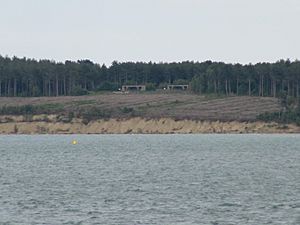Bouldnor Cliff facts for kids

Bouldnor Battery overlooking the Solent. Bouldnor Cliff lies under the water in front of the cliffs.
|
|
| Location | Bouldnor, Isle of Wight, United Kingdom |
|---|---|
| Region | Solent |
| Coordinates | 50°42′49″N 01°27′50″W / 50.71361°N 1.46389°W |
| History | |
| Periods | Mesolithic |
| Site notes | |
| Condition | Submerged |
Bouldnor Cliff is an amazing underwater place where people lived a very, very long time ago. This ancient settlement is found in the Solent, a strait of water in the United Kingdom. It dates back to the Mesolithic era, also known as the Middle Stone Age.
The site is about 11 meters (36 feet) deep underwater. It lies just off the coast of Bouldnor village on the Isle of Wight. What makes Bouldnor Cliff so special is that it has kept organic materials safe. These are things like wood that usually rot away on dry land. Because of this, Bouldnor helps us understand what life was like in Stone Age Britain. Some experts even call it "probably Europe's most important Mesolithic site," even though it's hidden underwater!
Divers from the Hampshire and Wight Trust for Maritime Archaeology first found the site in 1999. They noticed a lobster digging up old flint tools from its burrow on the seabed. Since then, archaeologists have worked for years. They found out Bouldnor was a busy settlement about 8,000 years ago. At that time, sea levels were much lower. The Solent was actually a river valley, not a sea. The discoveries at Bouldnor show that people in the Mesolithic era were much more advanced than we thought. Their technology might have been 2,000 years ahead of previous beliefs!
How the Site Formed
During the Mesolithic era, from about 8000 to 4000 BC, the western Solent was a sheltered river basin. It was full of woodlands and had rivers flowing into it. One river was near Lymington, and another, the Western Yar, drained near Freshwater.
As the sea level slowly rose, the Solent valley began to flood. The settlement area was covered by water. The rising waters then deposited layers of silt and mud. This mud covered the old land surface, keeping everything underneath safe and preserved.
Discovery of Bouldnor Cliff
Fishermen had been finding stone tools on the Solent seabed since the 1960s. But it wasn't until 1987 that divers found the remains of an ancient forest at Bouldnor. Scientists used radiocarbon dating on pollen from the forest. They found it was about 8,000 years old.
Later, regular dives showed a submerged cliff east of Yarmouth. This cliff had lots of peat, which is old plant material, from the same time period. The Hampshire and Wight Trust for Maritime Archaeology started mapping this underwater cliff. They picked four main spots to explore, calling them BC 1 to BC 4.
In 1999, divers were exploring BC 2, about 11 meters (36 feet) deep. That's when they saw the lobster digging up the worked flints. The lobster had dug through the thick mud that formed after the Solent flooded. It dug right into the original ground surface from when the Solent was dry land.
Since 1999, divers have excavated at Bouldnor every year. They found more things at BC 2 and BC 4. A new site, BC 5, was also found nearby. Diving in the Solent is hard because the water flows very fast. So, archaeologists use special methods to study the seabed. One method is 'box sampling.' They collect large areas of the seabed in metal boxes. Then, they bring the boxes to the surface to carefully dig through their contents on dry land.
What Was Found
Archaeologists have found many interesting things at Bouldnor Cliff. They discovered lots of burnt flints, piles of timbers (pieces of wood), and pits dug into the ground. Wood from this time usually doesn't last long in normal land environments. So, finding so much wood at Bouldnor makes the site incredibly important worldwide.
At BC 5, under a big pile of worked timbers, archaeologists found areas of burnt clay, burnt flint, and charcoal. They think this was the floor of a living space. Other timbers show signs of being carefully worked on. Some split oak pieces suggest that very large structures, or even boats, were being built there. Another piece of wood looks like it was shaped into a type of conduit (a tube for carrying things). This kind of find has never been seen before in Mesolithic archaeology. Some of the worked timbers show skills that were thought to belong to the Neolithic era, which was 2,000 years later than Bouldnor.
Burnt hazelnuts and oak charcoal were also found at BC 5. Like the wood, these organic materials usually don't survive well on dry land. A pit dug into the clay at BC 5 was filled with burnt clay lumps, charcoal, and burnt stones. A large piece of wood covered it. Looking at the pit walls, it seems the pit was filled with hot stones many times. Other trenches have revealed small wood chips, flint flakes from tool making, and even wound fibers that seem to have been used as string. Many of the finds suggest that people were not just living there, but also doing small-scale industries.
The amazing discoveries from Bouldnor are shown at the Maritime Archaeology Trust's Sunken Secrets exhibition. You can see it at Fort Victoria on the Isle of Wight.
Early Trade with Europe
In 2015, research found wheat DNA at the Bouldnor site. This type of wheat was not native to Britain. This suggests that people in Britain might have been trading with Europe much earlier than archaeologists thought. However, some scientists questioned this idea. They thought the wheat DNA was too perfect and might have been contamination. But the original researchers published a response, explaining why they believed their findings were correct.


